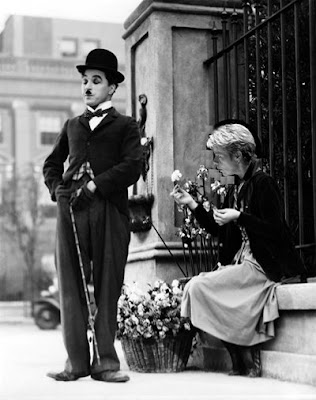
Charlie Chaplin and Marin Alsop in City Lights
image by Charles T. Downey (with apologies to Charlot) |
Friday evening, Marin Alsop led the Baltimore Symphony Orchestra in the film score of Charlie Chaplin’s City Lights (1931) during a screening in the Music Center at Strathmore. Alsop pointed out in her introduction that as screen writer, score writer, director, distributor, and the film’s star, Chaplin, having spent two years and eight months on the work, considered City Lights his greatest accomplishment.
Controversially released after the advent of “talkies,” City Lights opens with speeches by dignitaries -- a guy in a suit and a lady with a giant hat -- dedicating a new urban statue. Instead of the speakers’ actual voices, the orchestra created witty see-sawing noises followed by the unveiling of the statue. When its cover was lifted in front of a crowd of thousands, there slept the Little Tramp (Charlie Chaplin) in the lap of one of the statue’s characters. Beyond the film’s many comical sub-plots that incited gregarious guffawing from the full house, the chivalrous love story between the Little Tramp and the beautiful blind flower girl brought tears to many an eye. Slapstick was balanced with a serious love story.
With the musical score precisely attuned to each movement, including that of Chaplin’s eyebrow, Alsop led the orchestra through a score “la-lahed” by music-loving Chaplin to arranger Arthur Johnson. Kudos to the percussionist who cued his whistles exactly with Chaplin’s chronic whistling hiccups -- Chaplin accidentally swallows a whistle during a boozy party -- that interrupted a vocal presentation. Bustling roaring 20s tunes were contrasted with the sweet violin tune (La Violetera by José Padilla) of the blind flower girl. The tune is poetically heard as a duet between two violins at the end of the film when Chaplin reunites (he had been in prison… long story) with his love, the blind flower girl, no longer destitute and able to see.
The next program by the Baltimore Symphony Orchestra will combine Beethoven's Leonore Overture and Fifth Symphony with a new flute concerto by Christopher Rouse, on Thursday at Strathmore (March 6, 8 pm) and Friday through Sunday in Baltimore (March 7 to 9). Composer Christopher Rouse will speak in the Composers in Conversation series on Wednesday (March 5, 7:30 pm) at the Meyerhoff.






















































No comments:
Post a Comment